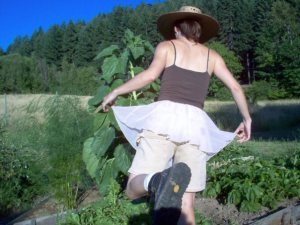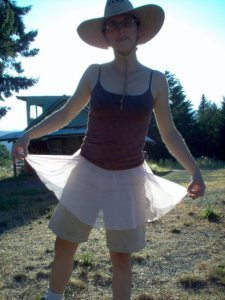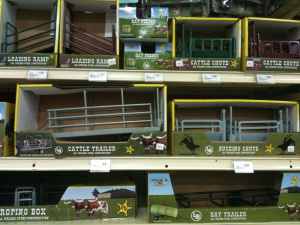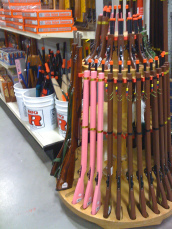Kristy Athens's Blog, page 13
October 14, 2012
A Sense of Place
At Get Your Pitchfork On! readings, people ask me what I miss most about living in the country and I answer, the land. I’ve been ending my readings with the opening to the Land Section, which I describe as a sort of love letter. Sometimes I have to fight back tears (and if you know me, you know I’m not predisposed to public weeping), because this makes me think about the plant-friends Mike and I left behind: the fruit trees we planted; the orchids, ginger and Indian pipe that grew in our woodlot; the Ponderosas in our field.
For the last eight years, I have participated in a special arts event in the Columbia River Gorge—the Plein Air Writing Exhibition. Held in conjunction with a painting competition, this program is sponsored by the Columbia Center for the Arts and takes place at the end of August. For five days, artists with canvases and notebooks descend upon pre-selected locations that offer gorgeous views.
The goal: capture a moment. Plein air painting is an art form that developed before photography. You’ve seen someone out on a hill with an easel and canvas, studying the horizon? That is plein air painting. The artist is attempting to re-create a specific view as quickly as possible—before the light shifts and the clouds move across the sky.
Writers do the same thing but have all of their senses, not just sight, at their disposal. Plus, they can incorporate their thoughts. Both art forms have their charms.
I generally don’t do a lot of nature writing, but I really enjoy this annual pilgrimage out into the land to try to put words to the love I feel for it. And, apparently, so do a lot of other writers! Julie Jindal coordinated this year’s program, and she put together the anthology of participants’ work, Blue Skies Forever Open. There you will find two of my pieces, “Glider” and “Ponderosa.”
The latter piece describes my longing to live in a rural place. I eagerly await the day Mike and I can move back out of the city!

October 7, 2012
Celebrating Harvest and Culture
In most of the world, food is cultivated rather than foraged. This means that seeds are planted in the spring, the young plants and trees are nurtured through the summer, and then the fruits of those plants and trees are harvested in the fall. Without exception, this harvest is a cause for celebration.
Ancient farming cultures had fascinating and intricate superstitions, myths, and traditions in hopes of ensuring future harvests. I’ve been thinking about how the harvest is celebrated in different parts of the world. Nowadays, we focus less on pleasing harvest gods and goddesses, and more on having a party before the long winter.
My husband Mike and I are European Americans, mostly Eastern Europe in Mike’s case and Western Europe in mine. We grew up in Minnesota, a state with a good number of Germans (though not as many as Wisconsin!), and went to elementary school in the 1970s. There was an effort in our suburb to re-popularize German culture, as it had taken a bit of a public-relations hit during the two World Wars. So, I had German-language instruction in my fourth-grade class, elected to take it from seventh grade on, and even studied it in college.
A couple of weeks ago, Mike and I decided to make it a heritage weekend. On Friday, we went to The Rhinelander in Portland. We eschewed the Oktoberfest party tent outside and settled into a booth in the pub, which ended up being much warmer and just as fun. A guy named Tony wandered through playing an accordion, and the waitstaff would occasionally stop everything to lead a round of “In München steht ein Hofbräu Haus” or “Ein Prosit der Gemütlichkeit.” Everyone joined in.

Eins, zwei, g’suffah!
We had a great time! I wondered why people don’t sing at the top of their lungs during every meal. Our waitress, Maria, told us she moved to Portland from Germany in 1982, and has worked at the restaurant ever since. She helped me decipher a few words in the old sayings painted in a mural across the walls.

“You should come back any time you want to speak German with me,” Maria said.
Since Northern Hemisphere cultures harvest at around the same time, autumn weekends can get busy in the United States. That same weekend there were also huge Greek and Polish festivals. Mike grew up with Bohemian and Polish food on his dad’s side, so he was very excited to go to Polishfest.
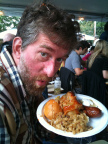
Clockwise from top: golumpke, pierogi, kielbasa, sauerkraut, bread. He already ate the pickles.
There was a loooong line at the food tent—lots of people share Mike’s passion for cabbage rolls. Thankfully, we got cups of Żywiec beer before we went for food, and then settled under the big tent to watch some traditional courting dances.
I mused about the variations of the same folk dances in so many cultures, even square dancing in the United States, all meant to give the kids a respectable way of feeling each other out for mating purposes.
German and Polish cultures are, all in all, pretty similar. There’s beer and sausages; modest folk dances in circles with elaborately embroidered costumes; pink-cheeked Caucasians; polka music. That same weekend, while cruising around Facebook, I noticed my friend Lara posted a photo of a leafy lean-to and wrote, “The sukkah’s up!”
“What on Earth is a sukkah?” I wondered.
Well. Yet another element of Jewish culture I knew nothing about. Despite all this talk of growing up around Germans, the western suburbs of Minneapolis were also home to many Jewish families (some were both, of course). I remember the Talmud Torah bus parked outside my elementary school in the afternoon, and those same Jewish kids, who had been learning German with me a few hours before, climbing aboard the bus after the bell rang to go learn Hebrew.
I felt like I knew a lot about Judaism, having grown up with dozens of Friedmans, Goldmans, Goldsteins and Bernsteins, and attending their bar and bat mitzvahs. But, the more I learn about Jewish culture the more I realize how deep it really goes. I could write an entire blog post about the sukkah, an element of the Jewish harvest fest (and pronounced soo-ka), but I will leave it to you to research. In short, it is a temporary outdoor hut that you decorate and eat meals in; it’s not unusual to go “sukkah-hopping” and check out your friends’ sukkahs. What a great tradition! I feel like I want to start building my own sukkah at harvest time.
The innovation of agriculture has had an enormous affect on human culture. Some of the first harvest celebrations honored Isis in Egypt, Demeter in Greece, and Ceres in Rome; their successors span the globe. How do you celebrate the harvest?

September 30, 2012
Bacon and Whiskey
In 2008, a short essay I’d written was accepted by a progressive literary journal—one that published its pieces exclusively on YouTube. Shape of a Box, run by Jessie Carty in Charlotte, North Carolina (and now called Referential Magazine), encouraged me to submit a video that included me reading the piece and whatever artwork I wanted to accompany it.
Little did she know, there was a television producer in the house. Mike and I shot “Bacon and Whiskey,” still one of Shape of a Box’s most popular pieces, on our farm. As I mention on my website, I didn’t intend it as a commercial for any particular brand of bourbon. It’s not even my favorite bourbon anymore (though still a household staple).
So grab some bacon, sip some whiskey, and enjoy! http://www.youtube.com/watch?v=qa1r010vtw0

September 23, 2012
On Autumn, Pears, and Reclamation
Maybe it’s the equinox. Maybe it’s because Mike was away for a few days. Maybe I’m getting my groove back. But the day before yesterday, I baked a crisp.
A few weeks ago, I met up with my friend and former neighbor (who makes numerous appearances in Get Your Pitchfork On!), Sue, for coffee-dessert-catch up. Sue had a very successful garden this year, and she sent me home with three grocery bags full of food!
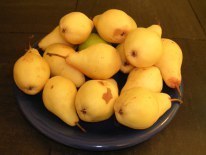
Beautiful Bartletts
The last of this bounty was a bowl of pears. I’ve been watching them get riper and riper, and worried that one morning I would find a pile of green fuzz instead of beautiful yellow fruit. The problem was, I have been unable to bake anything, or garden, since we moved.
When the Recession forced Mike and me to sell our beloved country property in 2009, we retreated to the city to regroup. The owner of the house we rented invited us to have a garden. But, I didn’t want one.
I was heartbroken. We had worked so hard to create our garden in the country: planting fruit trees, double-digging beds, putting up a fence with four gates, building a gazebo from trees cut from our land. The tiny strips of ground available around the edge of this urban backyard seemed insulting. To reference various cinema dramas featuring emotionally devastated children, I don’t want this crummy new garden; I want my old garden!
So, for the last three seasons, I’ve boycotted the soil. I cancelled my seed catalogue subscriptions, ignored the overgrown irises, and turned my back on the compost.
Ditto the kitchen. While I’ve never been the daily cook in the family (thank you, Mike) I had certainly put in my time behind the scenes: canning jams and fruits; painstakingly plucking and chopping every leaf off a half-dozen basil plants, crushing a pound of pine nuts, and pulverizing Parmesan for pesto; and cooking big batches of soup to freeze. I was getting fairly good at baking pies, especially pumpkin pies.
But no more. A year after we moved out, I half-heartedly made a pumpkin pie only to realize too late (at Thanksgiving dinner with my family) that I’d used evaporated milk instead of sweetened condensed milk, so there was essentially no sugar in it. I went back into retirement, still heartbroken.
Last week, Mike was out of town for work. Each morning, I looked at the bowl of pears and thought, I need to do something with those. On Tuesday, I moved them from the bowl onto a plate. I moved the plate closer to the coffee press. I moved the plate closer to the sink.
There has to be a statute of limitations on heartbreak, I told myself. Are you going to pout forever?
Finally, on Friday, I faced the pears.

Facing the pears
These were not grocery store blockbusters but modest Bartletts that fit in the palm of my hand. The skins were so tender they peeled off without a knife. I added a couple of apples for tartness, and cardamom, ginger and a bit of cinnamon. (And sugar, of course.) After 45 minutes, I could tell it was done because of the wonderful aroma swirling around the house. I’d forgotten how good that smells.
Mike returned from his trip shortly after the crisp came out of the oven. He raised his nose and sniffed.
“Have you been … baking?”
Yesterday morning, the crisp was part of a hearty Autumnal Equinox brunch. The pear flavor was intense, the perfect thing to welcome fall.
It feels good to reclaim my connection to harvest. Come spring, I might even plant some tomatoes.

September 16, 2012
Team Players
Sports are extremely important in the United States. School and intramural teams provide entertainment, activity for restless kids and a place for the community to gather. Professional sports is big business.
Many Americans are such great fans of sports that they want to live their political lives using the same framework. This leads to bumper stickers, t-shirts and infinite other bits of Made-in-China paraphernalia lauding one team or the other: Democrat or Republican.
Good thinking doesn’t split itself in two like that.
In the past few weeks, I’ve noticed a distinct smugness among my liberal friends. I’ve even gotten into trouble voicing this observation; one of my friends eyed me cautiously for an hour afterward, in case I had surreptitiously become a fascist.
I recently attended a public event in Portland celebrating a national environmental magazine. The host observed that at the recent Republican Party convention, the words “environment” and “nature” did not come up in analyses of the speeches. He followed this fact with the assertion that no Republicans care about the environment.
I did not hear even a murmur of surprise. Imagine how you’d feel if you were a Republican in the audience, someone who supports the magazine and chose to be there. Happily, one of the featured guests spoke of knowing some conservative women in rural Oregon.
“I disagree that they don’t care about the environment,” she said, facing down her host with an anecdote to illustrate the Eastern Oregonians’ warmth and generosity. “They just think about it differently.” I applauded loudly, ignoring the stares.
The issue strikes a chord with me because this “Us Versus Them” mentality is so pervasive, and so toxic. It might be fun to approach politics as one would a football rivalry, but it’s exclusionary and it’s damaging.
When the event host made his remark about the Republicans, he exuded confidence that everyone in the room was in agreement. I’ve seen this happen at parties, and I’ve seen it at work. It reminds me of what my friends who are people of color have described they experience in a room full of white people: things and ideas presented that are simply accepted as “normal,” which practice is actually, if unconsciously, racist.
People who have liberal views are not inherently better than those who have conservative ones. It seems elementary for me to say it, but conservatives love their children just as much as liberals do. They love the Earth. We all want more or less the same things; we just have different ideas about how to get there. To suggest that conservatives are Bad People is to be exactly as closed-minded.
So please, my liberal friends, please continue to think your thoughts. Continue to volunteer in your communities. Continue to talk to others about tricky issues. But please stop thinking your views are superior. More importantly, stop thinking you are superior.
Same goes for conservatives, of course. We are all in this together.
Instead, reach out to someone who is different from you and build a friendship, and then build on that trust to explore why s/he thinks what s/he thinks. Learn that person’s heart. Living in a liberal bubble is just as unhelpful as the worst conservative opinion imaginable, and vice versa.
I fully support debating issues. But being on one “team” and sniping at the other is, at the very least, bad sportsmanship.

September 9, 2012
Wild Fire
On Wednesday night I was glued to Facebook—not because I was catching up with the latest antics of my friends’ children or weighing in about the Democratic convention, but because the hills east of my old farm were on fire.
Like many places in the western United States, the Columbia River Gorge gets bone-dry in the summer. So dry that all outdoor burning is banned until the rains return. No campfires, no bonfires, no burn piles. If you use a charcoal grill you put it in the middle of your driveway and you have a hose at the ready.
Why so stringent? Because the Gorge has the perfect combination of conditions to host massive, fast-moving fires: lots of dry grasses and timber; nearly constant wind; steep terrain. Once a fire gets going, it can take days to stop it.
When I lived in the Gorge, such a fire started near the railroad tracks, at river level, south of Underwood. It climbed the bluff that rose 1,000 feet so fast that people who lived at the top barely made it down the hill with their lives. I recall a couple of anecdotes from the local newspaper: one from a woman who threw her kids in her rig and had to negotiate the road’s curves from memory because the smoke had completely obliterated her visibility.
Another interview was with a guy who had been waiting to see if he actually needed to evacuate (there are always holdouts in these situations). He put a few things in his car as the fire came closer. I remember the quotation in the newspaper being something like, “I was going back in the house for more stuff, when the oak tree in my back yard exploded. I decided it was time to leave.”
In Get Your Pitchfork On!, I talk about how difficult it is to get breaking news in these situations. Most people these days turn to social media to communicate to each other, usually Facebook or Twitter. On Wednesday night I sat, transfixed, as different friends up and down the White Salmon River Valley posted updates and photographs.
My friend Jeff, who lives north of Husum and has become something of a one-man news outlet for valley residents, took this shot on Wednesday evening while driving in a small group of cars that were being escorted through the fire zone. On Facebook, he wrote, “This was a tree that was crowning (official fire speak for ‘going up like a roman candle’) only about 10 feet off the highway.”
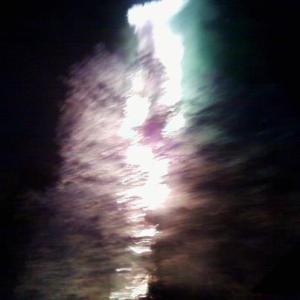
Photo by Jeff Lemley
The next photograph was particularly unnerving to me. Shot by my former neighbor, Emily, it showed just how close the fires were to my old farm. The building in the lower right of the photo was the old shop on our property, which we affectionately called “The Shack.”
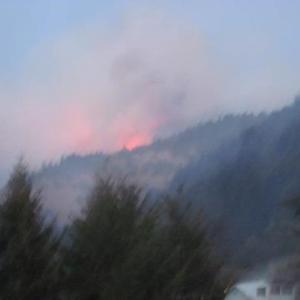
Photo by Emily Wanner
Even though Highway 141 lies between our old property and the burning hills, and our place wasn’t in imminent danger, thinking of it burning made me cry. The beautiful cedars and firs. The gazebo friends helped Mike and me build from logs in our woodlot. The chickens in the barn. It felt like losing our land all over again.
Four days later, the fire has scorched approximately 1,600 acres but is pretty much under control. Crews have defended every home in the area. It’s not over, but so far, so good. The fire’s source has not yet been determined though it was definitely human-caused, meaning anything from someone dragging a muffler on the pavement, to bored teenagers with a lighter, to a firefighter wanting to create a little job security.
As I write this, a new fire (started the old-fashioned way, by lightning) is taking off 20 miles further north, near Trout Lake …

September 2, 2012
Blue Moon in Jackson Hole
I have been ending my public readings with a quasi love-letter to the land. It’s the introduction to Get Your Pitchfork On!’s Land Section, in fact. In it, I write: “The night sky in the city is like a watered-down, warm soda—washed out by light pollution of all but the brightest stars and planets.”
On Thursday night, in Portland, Mike and I admired the nearly full moon on a walk around Mt. Tabor. It was truly gorgeous, rising bright and confident above the reservoir and towering evergreens. But, it was not a country moon. Quoting again from GYPO:
“In the city, you can’t appreciate the way [a full moon] bathes everything in a blue glow because everything in urban areas is lit with yellow, incandescent lights—between the streetlights, house lights and car headlights, it’s amazing anyone can sleep.”
So, imagine my thrill when the last blue moon until 2015 occurred Friday night, shortly after my arrival in Jackson Hole, Wyoming! (Just so you get your blues straight: a “blue moon” means the second full moon in one month, a rare occurrence.)
Visiting friends (and recent newlyweds—mazel tov!) Meg Daly and Mark Llinares, I was so engrossed in catching up that I nearly forgot about the moon, blue or otherwise. Shortly after 10, we stepped out the back door to find that it had risen above the tall buttes to the east. Brilliant. Even though small bands of roving clouds occasionally passed in front of it, the moon lit up the entire south end of the valley—the foothills of the Tetons, the cow pasture on the neighboring ranch—causing the aspen leaves next to the house to twinkle in silhouette.
My only camera is in my phone, so the following photograph does not begin to represent the silver-edged beauty of the clouds and the ethereal state of “nightday” that the land takes during a full moon. I could have gazed at it for hours.


August 26, 2012
Guest Blog: A Marvelous Tool
Today’s guest blog was sent to me by my Columbia River Gorge friend, Jim Tindall. Jim is a librarian for the local middle schools, which explains his admiration for the table of contents and index in Get Your Pitchfork On! He was the subject of my previous post involving chainsaws.
A Marvelous Tool
By Jim Tindall
While Get Your Pitchfork On! is an entertaining curiosity to the country dweller, which I am, it is truly crafted for those who have never had to prime a pump or negotiate with rodents living in the heating system of one’s rig. Encyclopedically written, it is a marvelous tool to assess what you know about the real challenges of country living.
I have both learned and re-learned a lot of information reading this book, from the practical like selection of farm implements to the spiritual, such as knowing the inevitability of your dog’s proclivity toward the “exquisite debauchery” of rolling in rotting flesh.
There’s tremendous value in this book, for reading a few hundred pages potentially could save you thousands of dollars. For example, in Chapter Six: Sustainable Power, Athens writes: “The best green power is conservation. It’s a good idea to explore conservation strategies before investing in green-energy infrastructure. As one friend put it, ‘You must be prepared to basically own and operate a private energy company.’”
There is surely a great convenience in having the power company maintain everything to your door; imagine the many sets of expertise you must have not to electrocute yourself.
This is writing that reveres nature. In Chapter Twelve: Wildlife, pests and predators are addressed. Cougars and bears are a reality, at least in the Cascades. Coincidentally I was driving the road that passes Athens’ former farm, and something big came upon the road just in front of me. I braked to see no less than Elsa from Born Free pass a few feet before my compact car. The cougar was THAT big!
As you contemplate a move, you must give plenty of thought to exactly how you intend to interface with nature. While big animals, carpenter ants, and yellow jackets may be real obstacles to tranquility, wild fires, floods, and wind events are far more unpredictable and require your attention in transplanting from an urban to a rural universe.
My hat goes off to both the author and the publisher because they have accomplished what many who work with nonfiction neglect. Both the table of contents and the index are superb. One does not need to read a whole book to glean what one needs at the moment, and Get Your Pitchfork On! is highly useful for this reason.


August 19, 2012
Tutu Therapy
In 2008, Mike and I were struggling financially. You probably were, too: there was a recession going on. I was getting for-real depressed.
That July, Mike had a freelance video production gig (thank goodness!) that required travel. While he was out of town, I drove to the Wallowa Mountains with my friend Laura to visit my other friend, Jon. We had a great time—just what I needed—and I dreaded returning to reality. On our way out of town, Laura and stumbled upon a big rummage sale being held in a parking lot. I found a child’s pink tulle tutu for 25 cents.
For some reason, I bought it. I had never owned a tutu. I never took ballet lessons as a girl. Laura looked at me like I had finally cracked.
I’m a petite gal, so it fit just fine. I made a tentative leap in the air, imagining myself graceful. I found that when I put the tutu on, my worries disappeared! The silliness of a grown woman who is not a ballerina wearing a tutu overcame my concerns about the things on the house that needed fixing and my fears about the future. I was wearing a tutu! Leap! Leap! Twirl!
Inspired, I created a photo essay that I posted on my Facebook page. Today, a friend turned my attention to a man who is posting photos of himself in a tutu to raise breast cancer awareness. I felt a bond with this man right away. I highly recommend tutu therapy!
Here is my photo essay, entitled “Tutu.”
Life is hard. Wearing a tutu makes things more fun!
Chopping wood is more fun!
Gardening is more fun!
Mowing is more fun!
Now I just need to wear my tutu during business meetings, balancing the checkbook and washing the dishes!


August 12, 2012
Raising Rural Children
One of your motivations for moving to the country may be to raise your children in a way that seems more natural and authentic. Wouldn’t it be great to scoot your kids out the kitchen door, saying “Don’t come back ‘til dinner!” They may grow up with a better understanding of the circle of life than their urban counterparts. They may be more self-reliant and responsible.
Keep in mind that, while your own rural experience is being acquired in addition to your years as an urbanite, your children will draw solely from a rural frame of reference. Unless you take them into a city on a regular basis, they will not know how to access public transportation. They may have never seen a person of color. They may not know how to deal with panhandlers and roving mentally ill. Not to mention driving and parking—the chaos! The signs and restrictions! How does this parking meter work? Your kids will see city life on TV and in movies, but it will be a fascinating abstraction, not instruction.
While visiting Burns, Oregon, in June I stopped by Big R, a farming and ranching supply store chain. They have everything! Horse tack, rat traps, ammunition, cowgirl fashion. I bought a pair of Ariat lace-up boots while I was there in 2009 and still wear them on a regular basis. On the way to see the new boot styles, I passed through the toy section. The toys include kid versions of what the grown-ups use—in this case not miniature condominiums and SUVs, but replica rodeo equipment and rifles. Lifelike for the boys and pink for the girls.
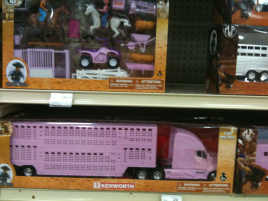
Yes, this is a pink cattle truck!
Children on working farms and ranches get up at 5:30 in the morning to do chores. Before breakfast, before school. Yours may not, but keep in mind that that’s the norm. This might disrupt the usual sleepover schedule.
Your children will grow up different from you. There are a couple of ways this can pan out. They may take up hunting, even though you never suggested it. They may join a church you would never step foot in. They may be terrified of the pace and crush of the city and refuse to visit.
Conversely, they may adore the city (or their romantic idea about it), viewing their hometown as anything but the beautiful refuge that you painstakingly chose and sacrificed to give to them. Many teenagers “hate” their home regardless of where it is—suburbia, urban ghetto, 5,000-square-foot mansion—that’s just a normal process of differentiating oneself from one’s parents. Your children may feel imprisoned in their rural oasis, waiting to burst forth from their “backwards” country cage.
Most rural kids are encouraged by their parents to attend college, knowing it will give them a chance to sample a world outside their hometown. While some will stay in the city, many return after a few years to start their own families. Good parents try to give their children the best life possible. Try not to have too many preconceived notions about what that means.








